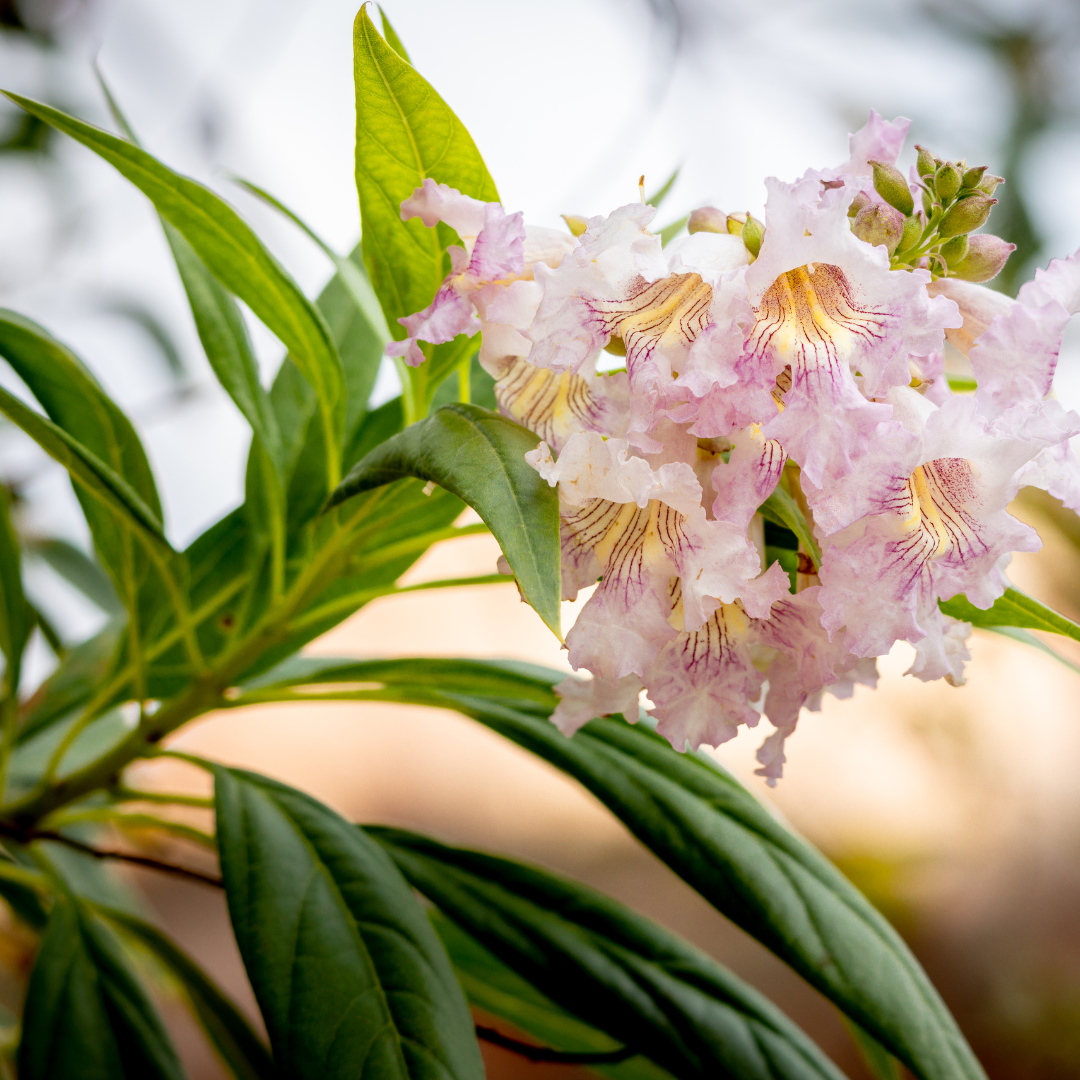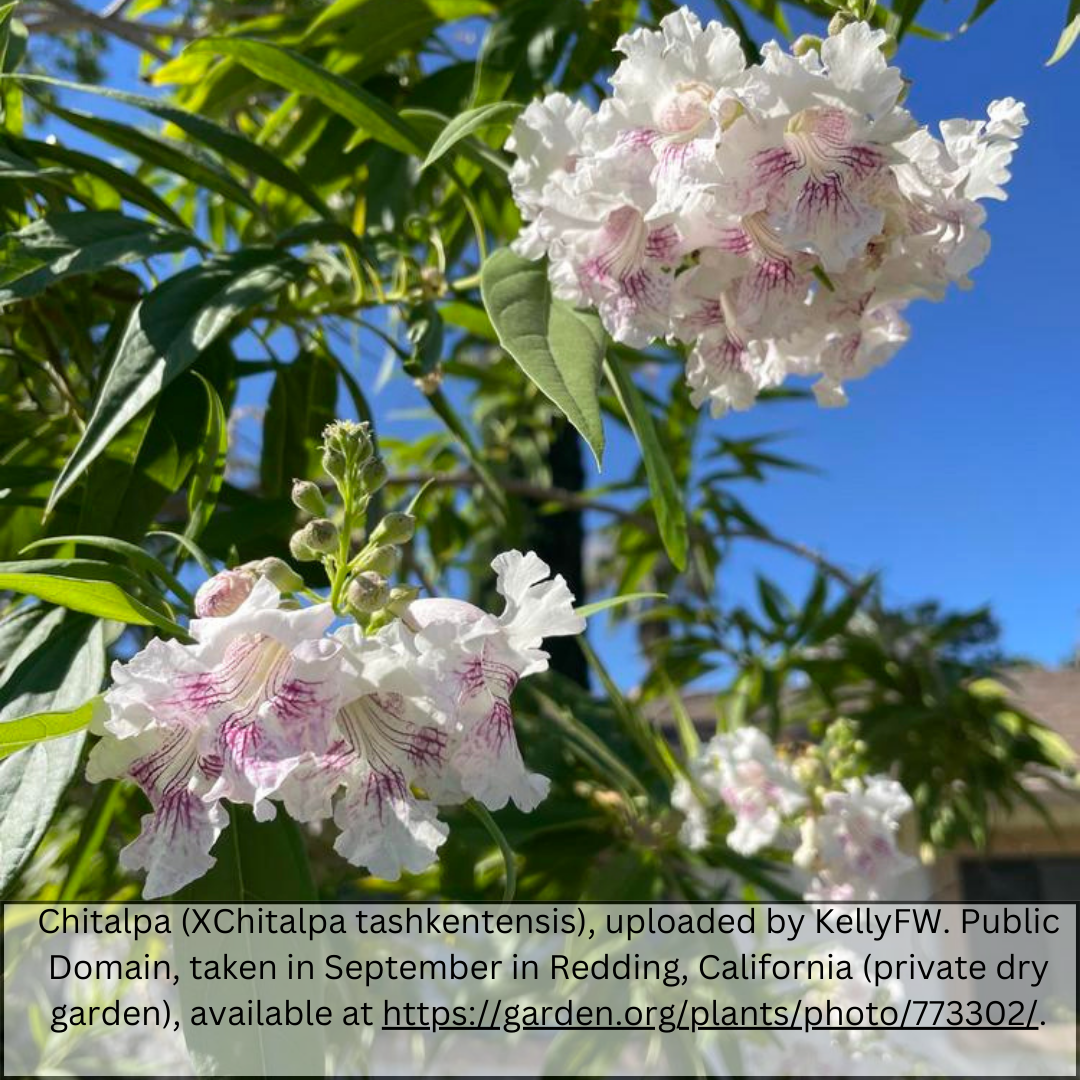My Store
Chitalpa
Chitalpa
Couldn't load pickup availability
Plant Type: Trees
Plant Height: 20-30 feet
Spread: 20-30 feet
Flower Color: pink, lavender or white
Sun Exposure: Full sun
Chitalpa Tree: The Perfect Heat-Tolerant Flowering Tree for Arid Landscapes
The Chitalpa is a stunning deciduous tree that combines the beauty and resilience of its parent species, making it an ideal choice for arid and semi-arid landscapes. Known for its fast growth, drought tolerance, and heat endurance, the Chitalpa thrives in warm climates and is an increasingly popular choice for gardens in desert regions.
Key Features of the Chitalpa
- Beautiful Blooms: Similar to the Desert Willow, the Chitalpa produces trumpet-shaped flowers throughout the summer, creating a vibrant display in shades of pink, lavender, and white. The flowers often feature yellow and purple markings that add visual interest and attract pollinators like bees and hummingbirds.
- Graceful Foliage: With long, narrow leaves reminiscent of a willow, the Chitalpa adds a soft, delicate texture to the garden. The foliage creates a lush, green backdrop that enhances the tree's vibrant blooms.
Growing and Care Requirements
- Sunlight: Thrives in full sun.
- Soil: Adaptable to various well-draining soils.
- Watering: Needs regular watering during the first growing season to develop a strong root system, after which it becomes drought-tolerant.
- Low Maintenance: Minimal pruning and care are required once the tree is established, making it a great choice for low-maintenance landscapes.
Landscaping Uses
- Specimen Tree: Use the Chitalpa as a focal point in gardens or mixed borders.
- Pollinator Gardens: The flowers attract hummingbirds and bees, enhancing the garden’s biodiversity.
- Small and Large Gardens: The tree’s moderate size makes it suitable for both large landscapes and smaller garden spaces.
Summary
The Chitalpa Tree is a standout option for hot, dry climates due to its ornamental beauty, drought tolerance, and ease of care. With showy flowers, willow-like foliage, and low water requirements, this tree is perfect for adding color, texture, and pollinator-friendly appeal to landscapes focused on water conservation and natural beauty.
Three Timbers Installation Guide (Feel Free to Follow): Chitalpa
Planting Guide:
- Location: Full sun (at least 6 hours of direct sunlight daily for optimal growth and flowering)
- Soil: Well-drained, loamy or sandy soil (slightly acidic to neutral soil preferred)
- Spacing: Space plants 10-12 feet apart to allow for optimal growth and proper air circulation
- Planting Depth: Plant at the same depth as the root ball, ensuring the top of the root ball is level with the surrounding soil surface
- Support: Chitalpa is a small tree or large shrub and may benefit from staking in its early growth phase
Watering Guide:
Watering After Planting:
- Initial Watering: Water thoroughly immediately after planting to saturate the root ball and surrounding soil
- Frequency: Water every 2-3 days for the first 2-3 weeks to help establish the root system
- Watering Amount: Provide 2-3 inches of water per session for deep watering
When is the Plant Established?
- Timeframe: Chitalpa is considered established after 3-4 months when the roots have spread into the surrounding soil
Watering Once Established:
- Summer: Water every 10-14 days during the hotter months. If temperatures exceed 100°F, increase watering to every 7-10 days. Provide 2-3 inches of water per session.
- Winter: Water every 4-6 weeks during the cooler months, depending on rainfall.
Drip Irrigation Setup:
- Placement of Emitters: Place the drip emitters 18-24 inches away from the base of the tree
- Flow Rate: Use emitters with a flow rate of 2-4 gallons per hour for slow, deep watering
- Number of Emitters: 2-3 emitters per tree
- Adjusting Frequency: In the summer, increase watering to every 7-10 days for hydration, and in winter, reduce to every 4-6 weeks
Share














